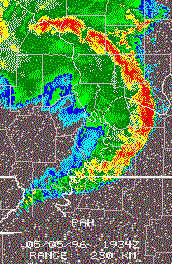


As you and your class start thinking about tornados, you might start by asking: why weather has been such an enduring question for human beings. Why does weather affect us so? Then you can start to look at storms.
Severe storms have evoked awe and fear in human beings throughout history. Storms have an elemental, destructive power that can make us feel very small. Scientists have long striven to understand these phenomena, so that they may someday be able to predict their occurrence and behavior. But much about storms remains a mystery. In the Eyeing the Storm event, students and teachers can join the ongoing conversation with scientists struggling to make sense of storms.
The field of meteorology, particularly the study of severe storms, is at an exciting
stage. For many years, scientists were limited in what they could learn about severe
storms, simply because the storms were too intense, too large, or too far away to for the
scientists to gather useful information.
Now, new tools in remote sensing have allowed scientists to gather large amounts
of information about storms. Powerful new supercomputers help scientists process
all that data, and then display the information in a visual model. Visual models are
often easier for human scientists to process: patterns that might be hard to see when
looking at raw numbers can emerge when a computer makes a "picture" of the data.

However, there is much that is still unknown about storms. Scientists do not yet understand all the causes and behaviors of violent and damaging storms such as tornados and hurricanes.
To prepare for your live conversation with the scientists, talk with your students about
storms. Do they have ideas about how thunderstorms happen? What about tornados? You
might have them explore some of the various weather and severe storm sites on the Web.
Once you find out from the
Then start generating questions. Write them all down; questions that may seem too simple
can actually turn out to be great questions. Scientists are still exploring some of the
most basic questions about storms (such as: "what is a tornado, really, and how does it
happen?"). The new visualization tools are yeilding new twists to these questions, and
in some cases, new answers.
Here are some links to information about severe storms,
and the visualization tools that scientists
use to study them:
 The Why Files
A good explanation of how tornados happen.
The Why Files
A good explanation of how tornados happen.
 The National Center for Atmospheric Research
The National Center for Atmospheric Research
 A Brief History of Meteorology
at the University of Oklahoma.
A Brief History of Meteorology
at the University of Oklahoma.
 Severe Weather Outbreak
A COVIS Project unit on how a tornado happens.
Severe Weather Outbreak
A COVIS Project unit on how a tornado happens.
 HOME
HOME